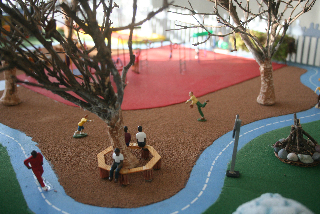
The landscape of the City Heights neighborhood of San Diego is challenging for people who want to stay healthy and prevent disease.
City Heights is 100 acres short of usable park space by San Diego guidelines, according to a 2012 KPBS report, and unhealthy choices are everywhere within its borders.
“Within seven square miles of City Heights, there are nearly 60 fast-food restaurants, 40 convenience stores and 120 liquor vendors,” according to a 2011 Health Equity by Design report by WalkSanDiego.
So perhaps it shouldn’t be surprising that hundreds demanded a skatepark in City Heights in December.

Peter Whitley is the programs director at The Tony Hawk Foundation, a San Diego County-based nonprofit that has made more than 500 grants to help build skateparks since its inception 10 years ago. According to Whitley, the foundation has helped open 420 parks, and he personally logged more than a thousand requests for skatepark consultation in 2012.
Despite this experience, Whitley said he has never seen anything like the Mid-City CAN skatepark rally Dec. 6 at Cherokee Point Elementary School. The rally was the culmination of the Mid-City CAN Youth Council campaign to add a skatepark to City Heights.
“Nobody shows up for a meeting on a recreational issue like that,” Whitley said, referring to the crowd of about 300 people at the event where “the seats were full to the back.”
Mid-City Community Advocacy Network is the City Heights hub for Building Healthy Communities. Building Healthy Communities is a 10-year, $1 billion plan of The California Endowment. Communities in 14 sites across California are taking action to make where they live healthier. In City Heights, part of that includes a campaign for more park space. The experience of the rally was unprecedented for Whitley.
“It doesn’t happen for a stadium,” he said. “It doesn’t happen for softball fields or anything – swimming pools or waterslides.
“You are breaking new ground and setting precedents that the city isn’t accustomed to,” Whitley said. “There is a lot of excitement there.”
City officials may have been unaccustomed to such a high level of community engagement about a parks issue – but they certainly took notice. Newly sworn-in San Diego Mayor Bob Filner said attending the rally was one of his first official acts as mayor, and he was unwavering in his support.
“We have a budget in our City of San Diego of $3 billion,” Filner said. “That’s a lot of money. If we can’t find the money to do this, we should pack up.”
Filner’s enthusiasm even led him to create a new motto for the effort. He led the crowd in a chant of a “Skate se puede.” Se puede is a Spanish phrase that translates roughly to “we can do it.”
San Diego school board president Richard Barrera also committed to aid the effort.
“Know that you’ve got the support of the entire school district – the entire school board,” he said.
“Our schools are open to you to do your planning and your visioning,” Barrera added. “We support you 100 percent.”
Cherokee Point Elementary School Principal Godwin Higa offered his perspective about how a skatepark could give young people a healthier future at the rally.
“We’ve got to do something about our kids being on the streets – it is so unsafe,” Higa said. “I’ve been working for four years – this is my fifth year – trying to get a skatepark somewhere close to this area, so it’s safer for the students than riding on the streets. We want to make this happen. Please support this.”
Whitley said it is more than school and elected officials paying attention.
“A lot is going on in Mid-City, we are really excited about this opportunity,” Whitley said at the Cherokee Point skatepark rally. “Tony Hawk talks about it. All the pro-skaters that show up talk about it – it’s just a matter of time.”
The catalyst for the skatepark campaign is an 18-year-old City Heights resident named Marcos Olascoaga.
About two years ago he was hit by a SUV while riding his skateboard in City Heights.
“He hit me hard on my left hip, and it just threw me onto the street and the sidewalk,” he said.
Luckily, a hospital visit revealed that nothing was broken, and Olascoaga had no internal injuries.
“But I still have a scar on my hip and a scar on my arm as well,” he said.
That accident led him to work with the Mid-City CAN Youth Council to build “a safe place, a safe skate park, for people here in City Heights,” he said.
Olascoaga has since left for Northern California to become the first member of his immediate family to attend college, but the campaign for a skatepark lives on in City Heights.
And Tony Hawk’s Whitley said Marcos could see his vision realized this year. The industry average for a higher-end skatepark is about $40 per square foot, he said. That does not include landscaping, benches, lighting or other improvements.
“Given the relative inexpensiveness of skateparks, compared to anything else that the parks department wants to do with their money, they should be able to put this on a faster track,” Whitley said. “I think you could probably get concrete poured in the ground by at least the end of 2013.”
Adam Ward is a media specialist for Mid-City CAN (Community Advocacy Network).






You must be logged in to post a comment.